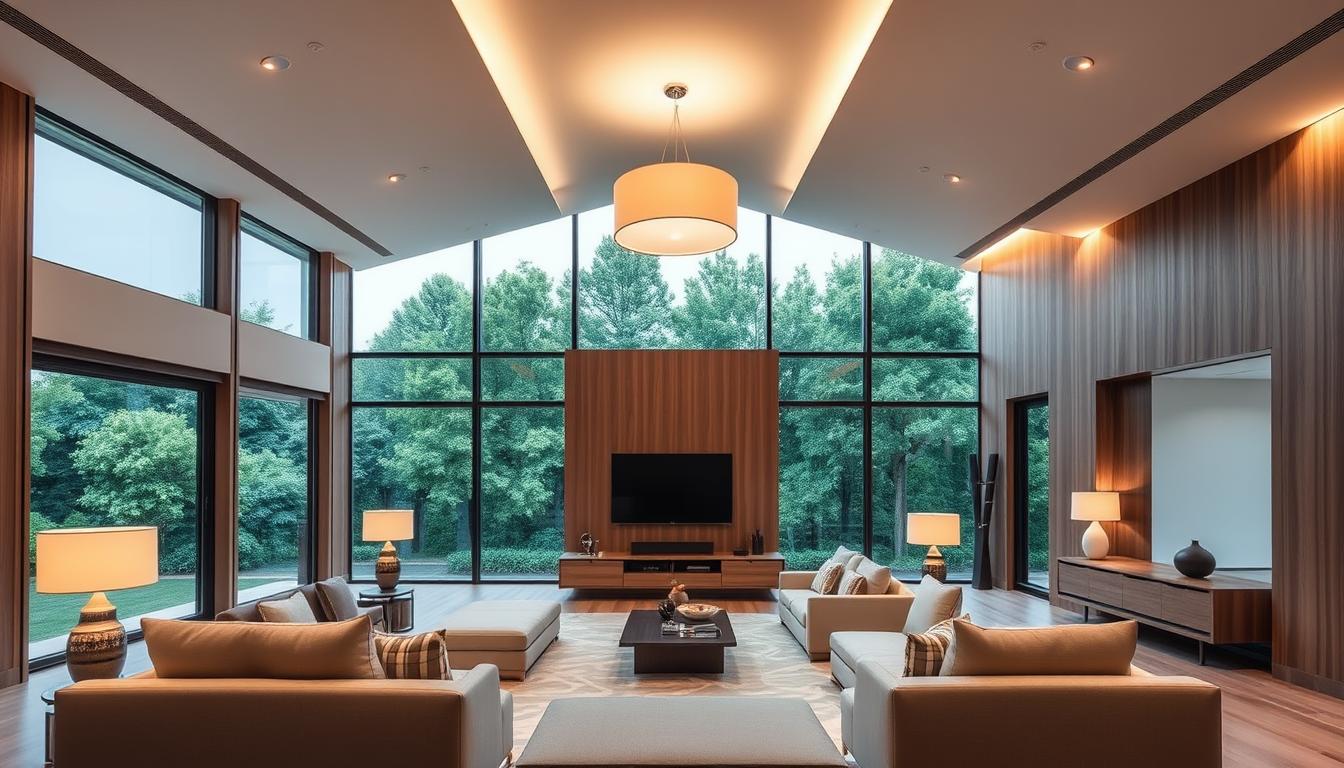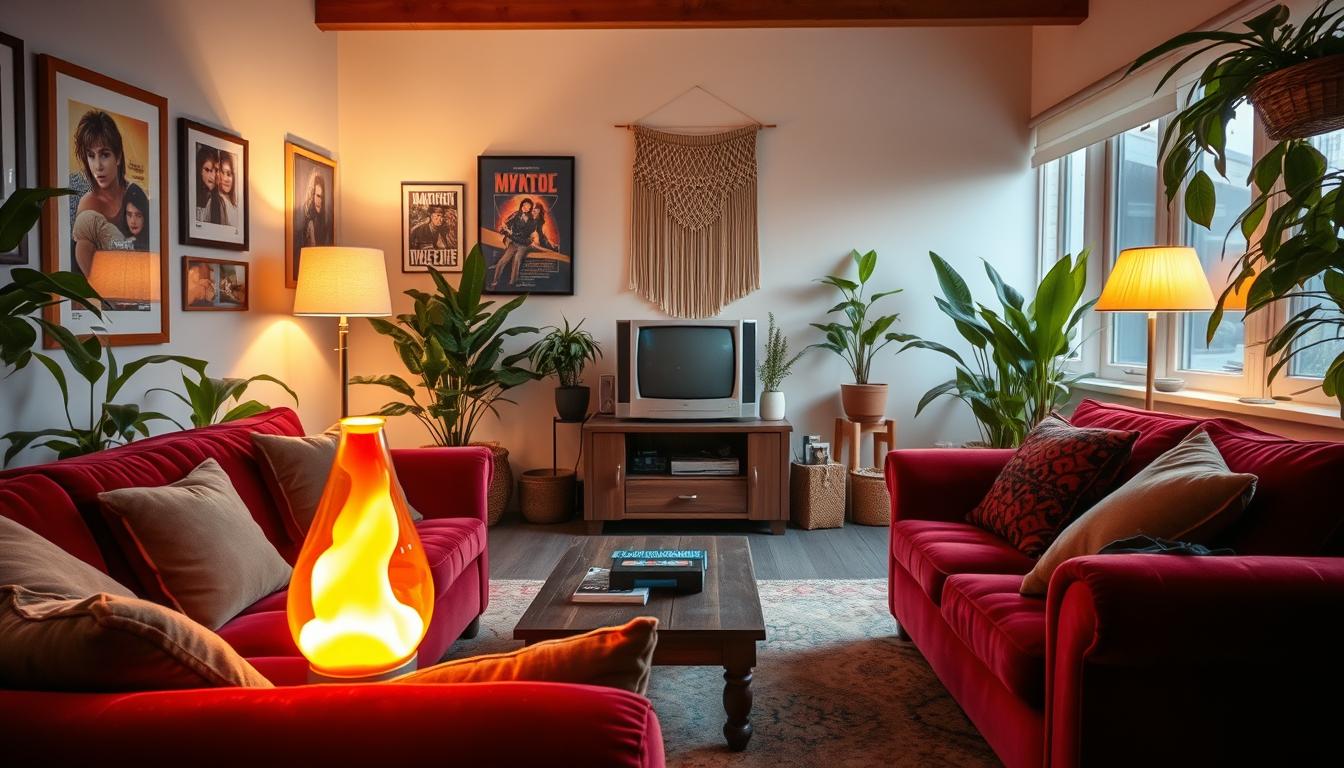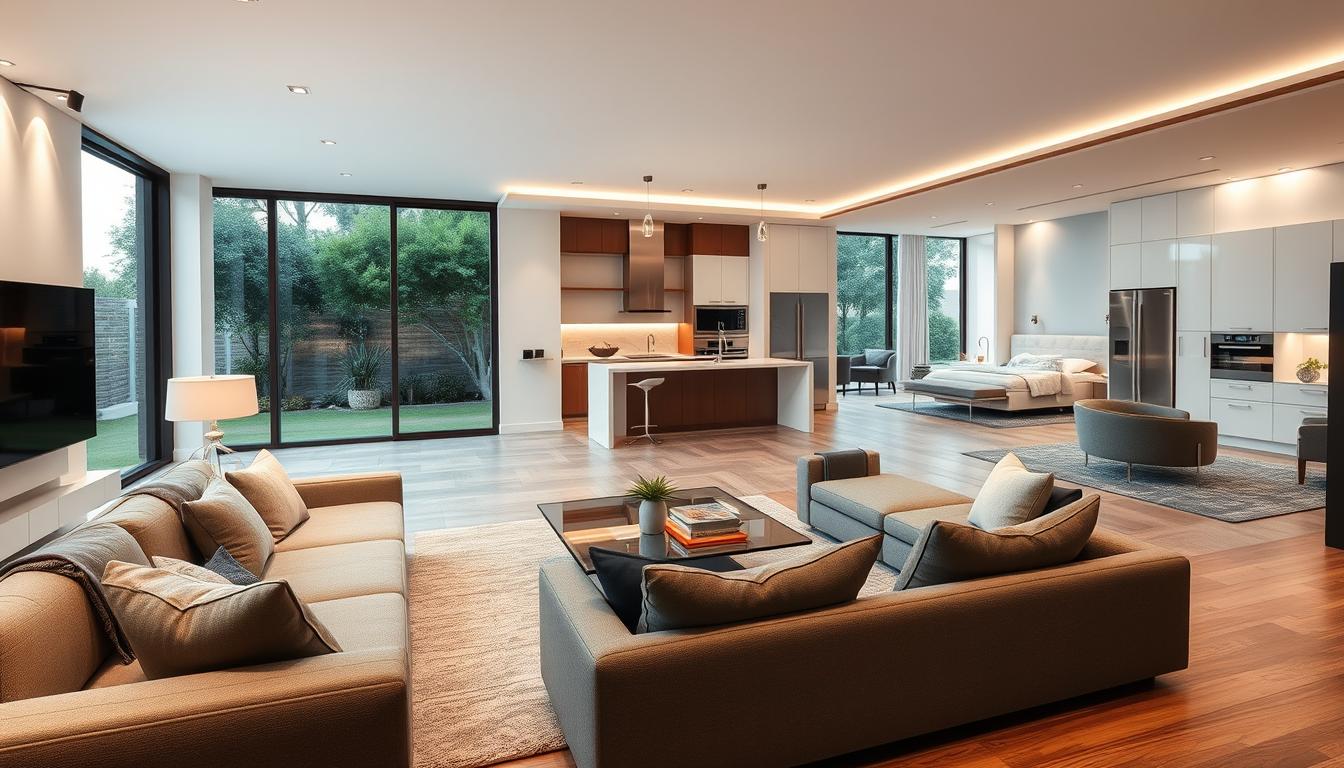Did you know the global smart home market is set to hit $146 billion by 2025? This huge growth marks a big change in how we live and interact with our homes. Smart home interior design is now key to modern living.
Our homes are changing in big ways. Smart home technology is more than just gadgets. It’s about making our homes work better for us. In this article, we’ll look at how smart home technology in interior design is changing our homes.
Key Takeaways
- Understanding the concept of smart home interior design
- The role of technology in transforming living spaces
- Benefits of integrating smart home technology in interior design
- Future trends in smart home interior design
- Practical tips for implementing smart home solutions
What is Smart Home Interior Design?
Smart home interior design is more than a trend. It’s a way to make our homes efficient, convenient, and green. Our homes are getting smarter, thanks to new tech that makes life better.
Definition and Overview
Smart home interior design mixes tech and automation into home design. It lets homeowners control things like lights, temperature, and security with ease. This is done through systems or apps on our phones.
This design aims to make our homes seamless and easy to use. With advanced tech, our homes become more comfortable and fun to live in.
The Role of Technology
Technology is key in smart home design. It makes homes look good and work well. Think smart thermostats and lights that change with the day.
Home tech lets us personalize our living spaces. For example, smart systems can do tasks for us, like setting the lights and temperature. This makes life easier.
Benefits of Smart Home Design
Smart home design offers many benefits. It makes life easier, more comfortable, and saves energy. It also boosts security. With smart tech, our homes become more enjoyable places to live.
Some main benefits are:
- Convenience through automated systems
- Energy savings with smart devices
- Improved security with smart locks and cameras
- Customizable living experiences
| Benefits | Description |
|---|---|
| Convenience | Automated systems simplify daily routines |
| Energy Efficiency | Smart devices reduce energy consumption |
| Security | Smart locks and cameras enhance home security |
“The future of home design is not just about aesthetics; it’s about creating a living space that is intelligent, efficient, and responsive to our needs.”
As we dive deeper into smart home design, it’s clear tech is changing how we live. By embracing smart home trends, we can make our homes beautiful, smart, and sustainable.
Key Features of Smart Home Interiors
Smart home interiors are becoming more popular. They offer comfort, convenience, and the latest technology. The key feature is integrating systems and devices for a seamless living experience.
Automation and Control Systems
At the heart of every smart home are automation and control systems. These systems let homeowners control lighting, temperature, entertainment, and appliances with a single interface. This is often through a smartphone app or voice commands. Smart home automation in design makes daily routines easier and enhances living.
For example, smart lighting systems adjust brightness and color based on the time of day or ambient light. This creates a comfortable atmosphere while saving energy. “The future of home design is not just about looking good, it’s about being smart and efficient,” says a leading interior designer.
Energy Efficiency Solutions
Energy efficiency is key in smart home design. Smart thermostats, like those from Nest or Ecobee, learn a home’s temperature preferences. They adjust the temperature to optimize heating and cooling. This improves comfort and reduces energy use, leading to lower bills.
Smart home gadgets, like smart plugs and power strips, can be controlled remotely. They can turn off devices not in use, reducing energy waste.
Integrated Security Systems
Security is a top concern for homeowners, and smart home interiors address it with integrated security systems. Smart locks, security cameras, and doorbells with cameras provide real-time monitoring and alerts. This ensures homeowners are always informed about their home’s security status.
These systems can be controlled and monitored through smartphones. This gives peace of mind whether at home or away. “Smart security systems are no longer a luxury but a necessity for modern homeowners,” notes a security expert.
In conclusion, smart home interiors have key features. Automation and control systems, energy efficiency solutions, and integrated security systems work together. They create a living space that is modern, stylish, functional, and secure.
Essential Smart Home Devices for Interior Design
Smart home devices are changing how we live. They make our lives easier, more efficient, and stylish. They also help us live more sustainably and connect better with our homes.
Smart Lighting Options
Smart lighting is key in smart home design. It lets us control lights from anywhere or set them to save energy. Brands like Philips Hue and LIFX have smart lights that fit any home.
- Philips Hue: Offers a wide range of smart light bulbs and fixtures that can be controlled via an app or voice commands.
- LIFX: Provides smart lighting solutions with vibrant colors and a variety of effects, all controllable via smartphone.
Smart Thermostats and HVAC
Smart thermostats and HVAC systems learn your temperature preferences. They make your home comfortable while saving energy. Brands like Nest and Ecobee have features like geofencing and smart alerts.
| Brand | Key Features | Compatibility |
|---|---|---|
| Nest | Learning thermostat, geofencing, energy reports | Amazon Alexa, Google Assistant |
| Ecobee | Smart sensors, remote sensors, smart alerts | Amazon Alexa, Google Assistant, Apple HomeKit |
Smart Speakers and Sound Systems
Smart speakers and sound systems do more than play music. They control other smart devices in your home. Brands like Amazon and Sonos offer great sound and work well with other smart home products.
For more on creating a connected home, check out our article on Discover the Secrets of Smart Home Interior.
Creating a Connected Living Space
A connected living space is the heart of a smart home. It combines technology and design smoothly. To make our home smart, beautiful, and useful, we must focus on a few key areas.
Designing for Connectivity
Designing for connectivity means setting up our smart home’s infrastructure. This setup lets devices talk to each other without trouble. Here’s what we need to do:
- Install a strong Wi-Fi network in every corner of our home.
- Choose smart home protocols like Zigbee or Z-Wave for device compatibility.
- Plan for future upgrades and additions.
By thinking about these steps, we can make a home that’s truly connected and ready for tomorrow.
Selecting Compatible Devices
Choosing devices that work well with our smart home system is vital. We should pick devices that:
- Use the same communication protocol (like Zigbee or Z-Wave).
- Are certified by the same smart home platform (Google Home or Amazon Alexa).
- Have good reviews from other users.
Compatibility is essential for our devices to work together smoothly. This gives us a better user experience.
Importance of a Smart Hub
A smart hub is the brain of our smart home. It connects different devices and systems. The benefits of a smart hub are:
- It makes controlling everything easier with one interface.
- It boosts automation features.
- It improves security and monitoring.
By getting a smart hub, we can maximize the benefits of our smart home design. This makes our living space convenient and safe.
Balancing Aesthetics and Functionality
As we add more technology to our homes, it’s key to keep things looking good and working well. In modern smart homes, finding this balance is essential. It helps make our living spaces both beautiful and useful.
Stylish Smart Furniture Choices
Choosing the right smart furniture is a big part of this balance. Smart furniture that looks good and works well can really improve a smart home’s design. For example, smart sofas with USB ports and charging stations are both useful and stylish.
When picking smart furniture, think about your home’s overall look. Minimalist designs are often a good fit for modern smart homes. They focus on clean lines and simplicity, making the tech blend in smoothly.
Blending Tech with Traditional Design
Mixing technology with traditional design is also key in smart home interiors. This means using smart devices that match the home’s decor, not clash with it.
For instance, smart lighting systems can be made to look like traditional fixtures, adding both function and style. Smart thermostats can also be picked to match the home’s look, so they don’t stick out.
Using Color and Materials Wisely
Choosing the right colors and materials is crucial for a nice-looking living space. In smart home decor, these choices should go well with the tech and the home’s design.
Neutral color palettes are often best in modern smart homes. They offer a clean background for the tech. Materials like glass, metal, and wood can also add warmth and texture, making the space more appealing.
By thinking carefully about these elements, homeowners can make a smart home that’s both functional and beautiful. It becomes a welcoming space for everyone.
Enhancing Comfort and Convenience
Smart home technology is changing how we live. It’s not just about looks anymore. It’s about making our homes more comfortable and easy to use.
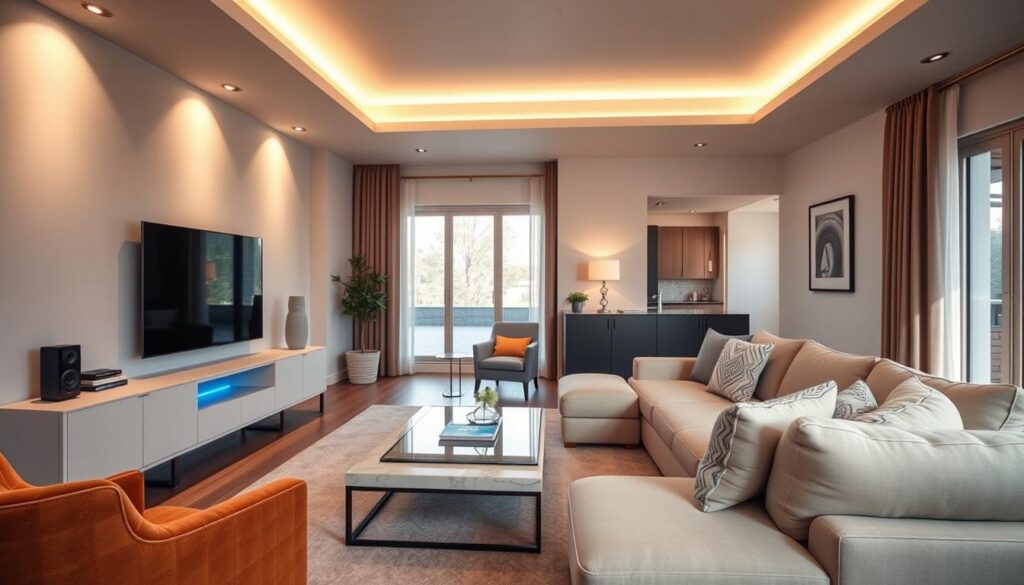
Features for Daily Living
Smart home features make our daily lives easier. For example, smart lighting systems adjust to the time of day or what we’re doing. This ensures the right light for any moment.
Smart thermostats learn our schedules and likes. They adjust the temperature to keep us comfy and save energy.
- Automated lighting and temperature control
- Smart home security systems for peace of mind
- Voice-controlled assistants for ease of use
Customization Options for Users
Smart homes let us tailor our space to our tastes. We can change lighting colors and room temperatures. This makes our home feel just right for us.
Smart home hubs let us control all our smart devices from one place. This makes managing our smart home easy and fun.
Multi-functional Spaces
Smart homes are all about flexible spaces. Rooms can change uses without big changes. For example, a living room can turn into a movie theater with just a button.
- Utilizing smart furniture that adapts to different needs
- Incorporating technology that enables spaces to change functions
- Designing rooms with flexibility in mind
Smart home design makes our homes more comfortable and valuable. As we move forward, homes will keep getting smarter and more flexible. This will change how we live and interact with our homes.
Sustainability in Smart Home Design
In the world of smart home design, being green is key. As we use more smart tech, we must think about how it affects our planet.
We can make homes that save energy and are good for the environment. This means using eco-friendly devices, cutting down on energy use, and picking sustainable materials.
Eco-friendly Smart Devices
Today, we have many green smart devices. For example, smart thermostats learn your habits and adjust the heat. Smart lighting systems can turn off when you’re not around, saving energy too.
A study found homes with smart tech can use up to 30% less energy. This shows how smart homes can be better for our planet.
Reducing Energy Consumption
Lowering energy use is vital for green smart homes. Smart devices and systems help a lot. For instance, smart power strips can cut off power to devices when not in use.
“The future of smart homes is not just about being connected; it’s about being sustainable.” –
Adding solar panels to smart homes also helps. It means using less non-renewable energy.
Choosing Sustainable Materials
The materials we choose matter a lot for sustainability. Going for sustainable, recycled, or recyclable options is smart. Using reclaimed wood or bamboo for furniture is a great choice.
- Reclaimed wood for flooring
- Bamboo for furniture
- Low-VOC paints
By picking the right materials, we can make homes that are both beautiful and eco-friendly.
Smart Home Design for Safety and Security
Smart home design is more than just about looks and ease. It’s also about keeping us safe and secure. As we add more tech to our homes, we must think about how it can protect us and our families.
Implementing Smart Alarms and Cameras
Smart alarms and cameras are key to a safe smart home. They can be controlled from afar and send alerts in real-time. For example, smart doorbells with cameras let us see who’s at the door, even when we’re not there.
These cameras can go inside and outside, giving us a full view of our surroundings. They often have night vision, motion detection, and facial recognition. This makes them great at keeping intruders away.
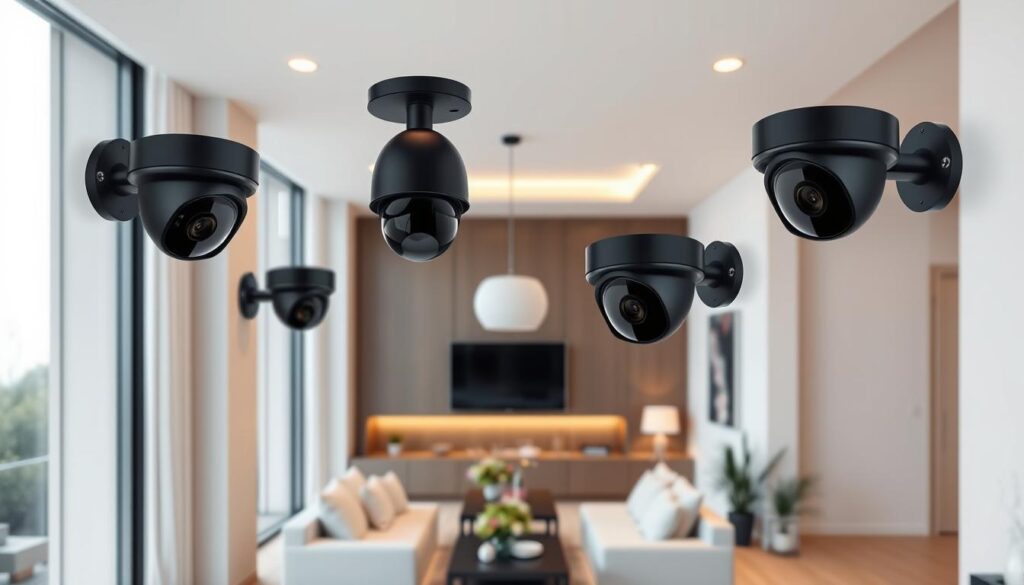
Benefits of Smart Locks
Smart locks are a big step up from old-fashioned locks. They can be controlled through apps on our phones. This is super handy for letting guests in or for service people.
Smart locks also work well with other smart home devices. For instance, when you turn on your security system, your smart lock can lock your doors automatically. This keeps your home safe.
Monitoring with Mobile Devices
Being able to watch our homes from anywhere is a big plus of smart home security. With our phones, we can see what’s happening in our homes in real-time. We get alerts if there’s a security issue.
For more tips on making your home stylish and safe, check out Trendy Interior Design Homes. It has great advice on creating a home that looks good and is secure.
By adding smart alarms, cameras, locks, and mobile monitoring to our homes, we make them much safer. These technologies work together to give us a strong security system. This gives us peace of mind and keeps our homes and families safe.
The Future of Smart Home Interior Design
Smart home interior design is on the verge of a new era. This is thanks to new technologies and design ideas. We must look at the trends and advancements that will shape tomorrow’s smart homes.
Upcoming Trends to Watch
Artificial Intelligence (AI) and Internet of Things (IoT) devices will be key. They will make homes more responsive to our needs. This will improve comfort and efficiency.
Some trends to watch include:
- Increased use of voice control and smart assistants
- Integration of smart home systems with wearable technology
- Advancements in energy harvesting and storage
Predictions for Consumer Technology
Consumer technology will keep evolving, leading to new smart home devices. These devices will be both functional and stylish. They will fit well into modern homes.
5G connectivity will be crucial. It will make data transfer faster and connections more reliable. This is important for smart security systems that need real-time data.
Innovations in Interior Design
Innovations in interior design will also be key. Designers will need to mix technology with beautiful, functional spaces.
Some innovations we can expect include:
| Design Element | Innovation | Benefit |
|---|---|---|
| Smart Furniture | Integration of technology into furniture design | Enhanced functionality and comfort |
| Smart Lighting | Advanced LED technology and color changing capabilities | Improved ambiance and energy efficiency |
Looking ahead, smart home interior design will evolve with technology and design. By keeping up with trends and technologies, homeowners and designers can create beautiful, functional spaces.
Getting Started with Your Smart Home Project
Now that we’ve looked at smart home interior design, it’s time to start your project. First, we need to check your space and find areas for smart tech improvements.
Assessing Your Space
Start by looking at your home’s layout. Decide which rooms need smart home decor ideas. Think about natural light, how people move, and what’s already there to make smart gadgets fit well.
Budgeting for Smart Improvements
Setting a budget is key for a good smart home project. Look up smart home devices and their prices to see what you can afford. Knowing about smart home interior design helps you choose wisely.
Finding Professional Help
If you’re not sure what to do, talk to experts in smart home design. They can offer great advice and guide you. This way, your smart home will be both useful and look good.

